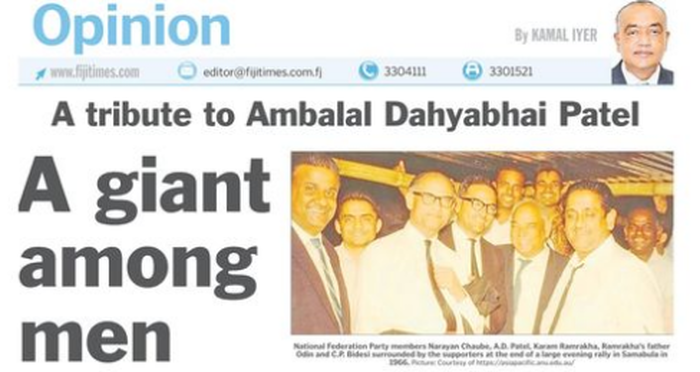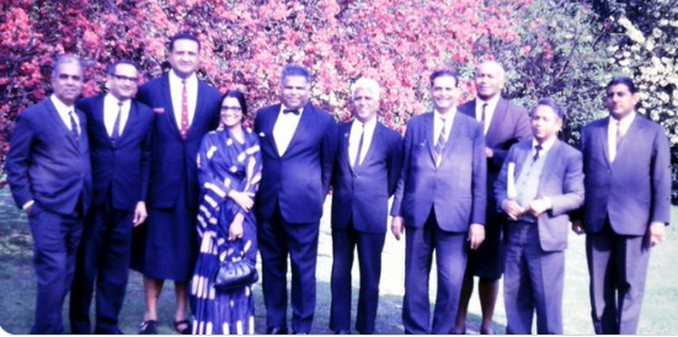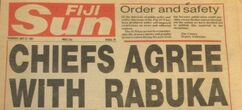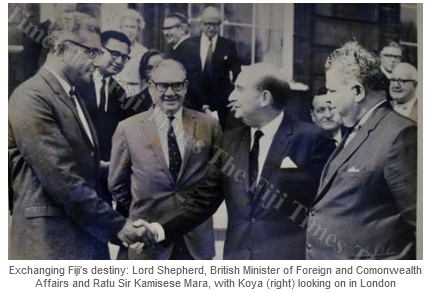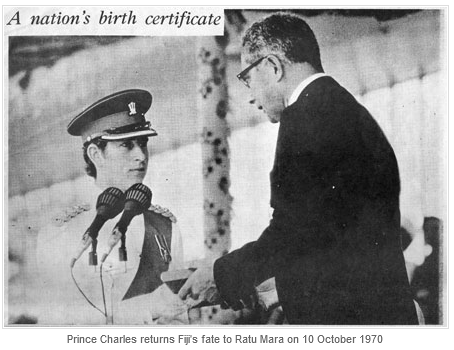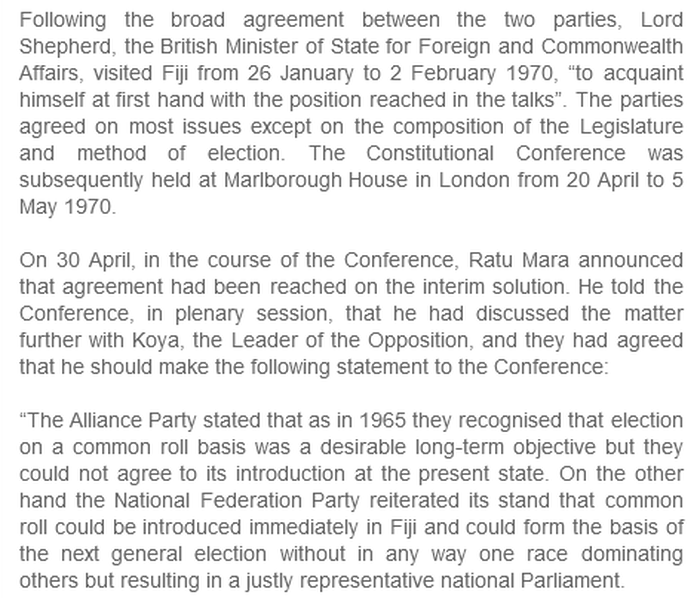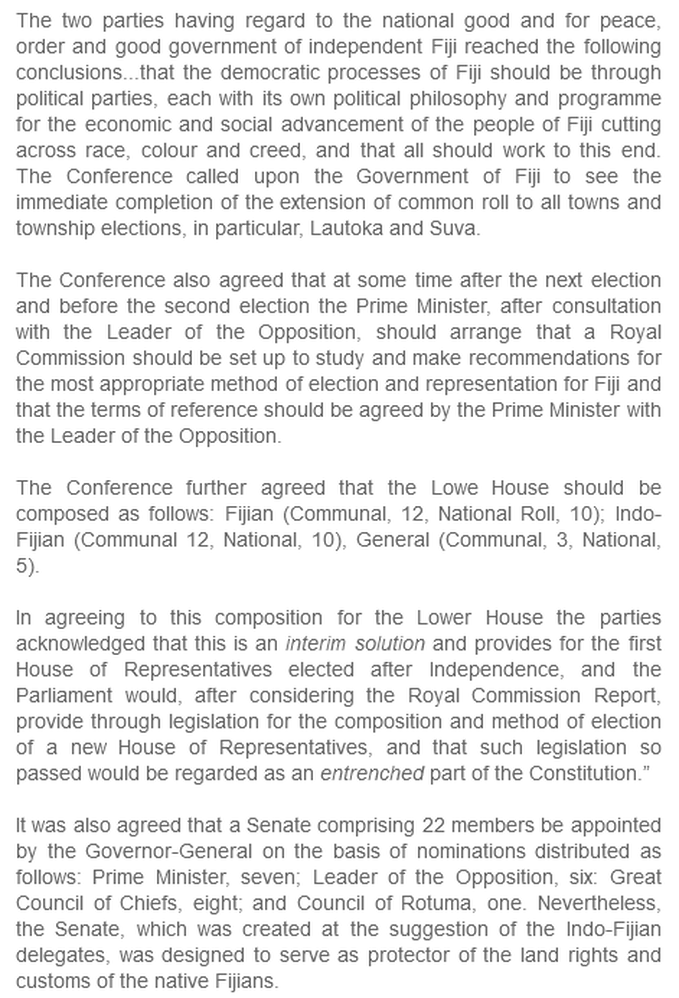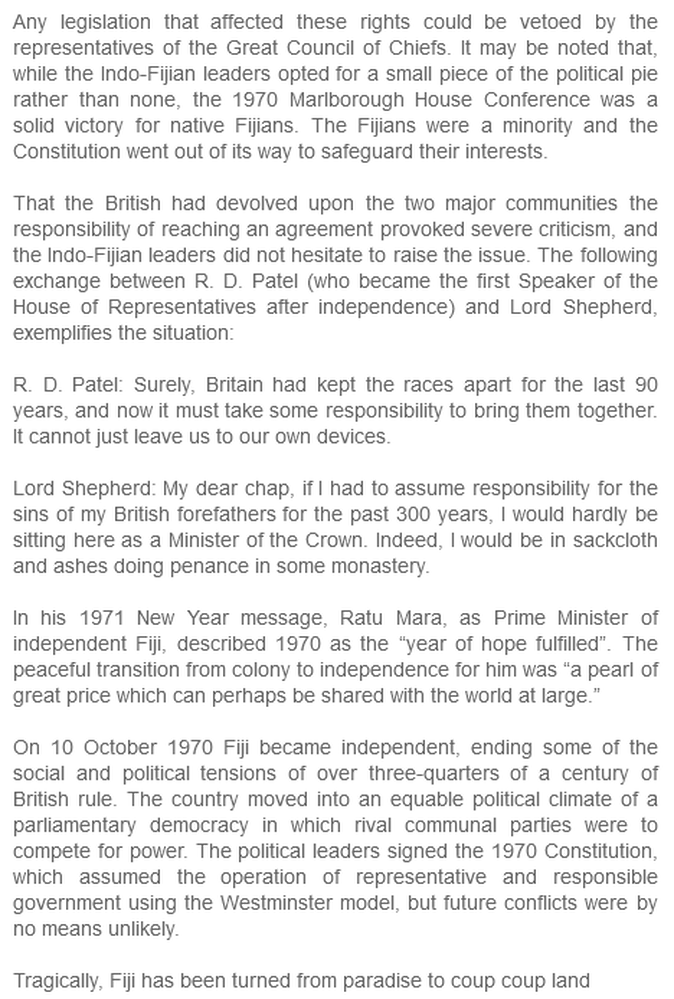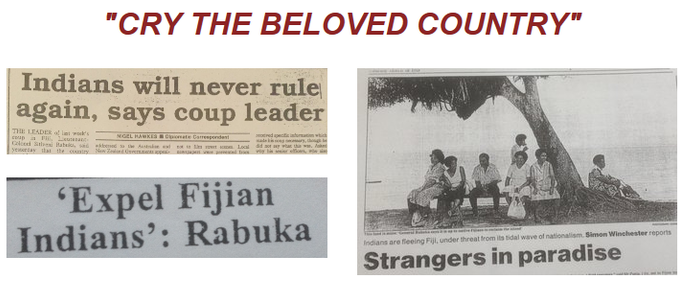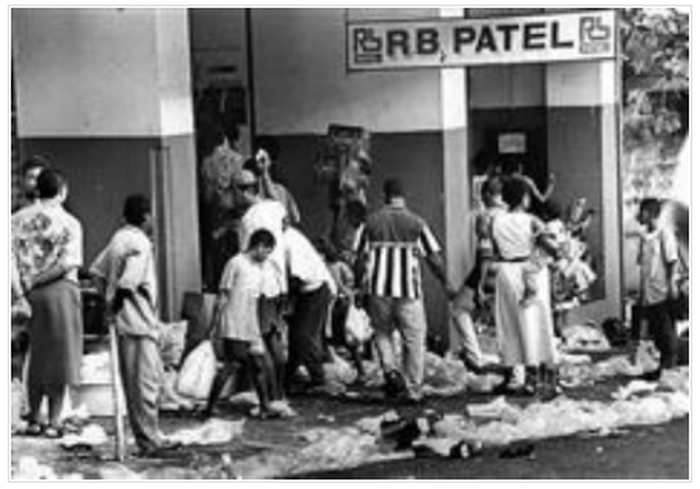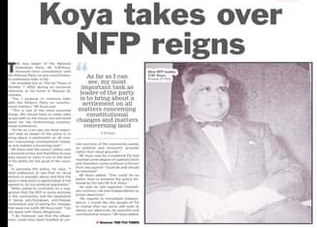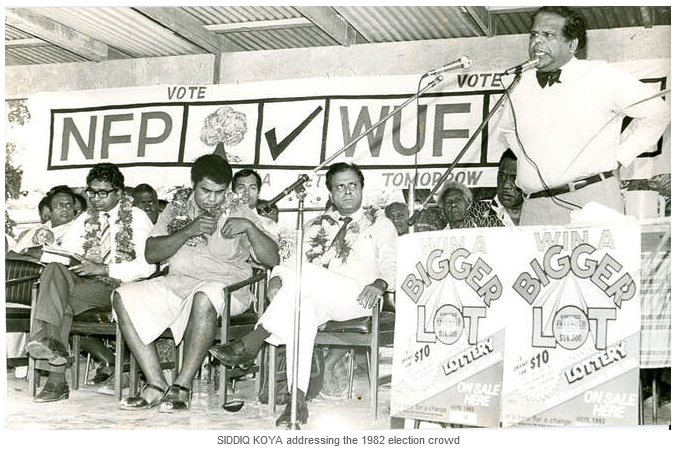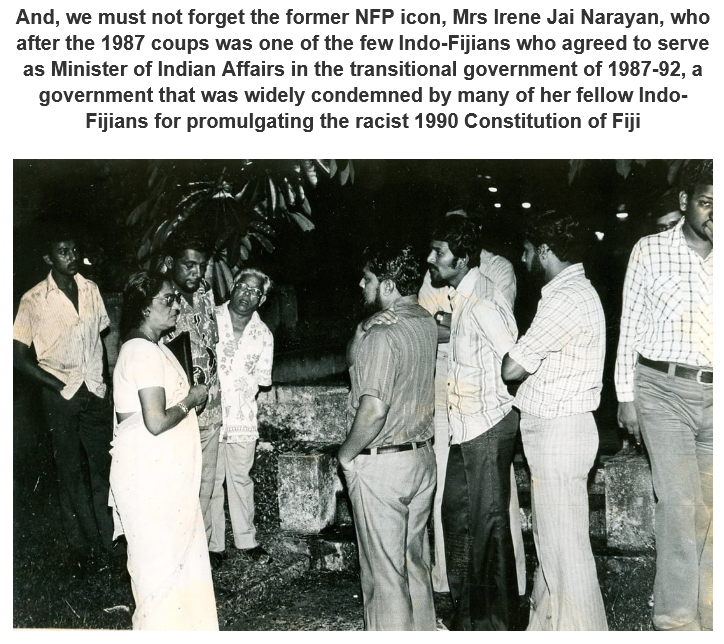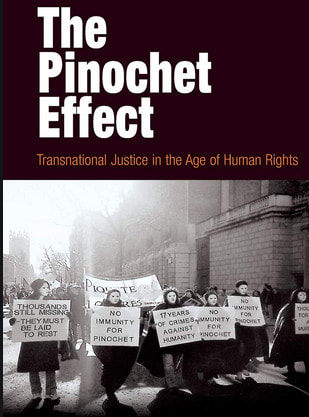Fijileaks: The recent glorification of NFP founder and leader AD PATEL
in the Fiji Times is all HOGWASH. The London Constitutional talks, even though Patel had passed away before the talks, revolved around majority and minority population rights, without taking into account the fact that the Indo-Fijians were on their way to becoming a minority race in Fiji
*There were projections that by 1988 the Fijian (i-Taukei) population would overtake the Indians (Indo-Fijians) as the largest racial group in the country. Apart from the far-reaching implications, this trend also raises a fundamental question: which group is to be treated as a minority in need of constitutional and political safeguards?
Chapter One
"Fiji: A New Nation is Born", Excerpt from VICTOR LAL,
Fiji: Coups in Paradise - Race, Politics and Military Intervention, 1990
*A deeper study of the decision reached at the London constitutional talks, however, shows that fear of Fijians (i-Taukei) being swamped by the majority Indians (Indo-Fijians), because the two races were 'equally numerous racial groups, effectively two "majority" communities, each large enough to view itself as capable of assuming a majority role, giving it the right to rule, was an oversimplication.
*Apparently no consideration had been given to future population trends which could result in Indians (Indo-Fijians) becoming a minority in Fiji. In fact, in 1976, for the first time since censuses had been conducted, the number of persons of Indian origin had declined as a percentage of the total population, once more constituting just under 50 per cent of the total population.
*There were also projections that by 1988 the Fijian (i-Taukei) population would overtake the Indians as the largest racial group in the country. Apart from the far-reaching implications, this trend also raises a fundamental question: which group is to be treated as a minority in need of constitutional and political safeguards?
*All the current indicators suggest that the Indians (Indo-Fijians) are on their way to becoming a minority. The latest population figures released in 1986 reveal that the Fijian (i-Taukei) percentage increased from 44.2 in 1976 to 46.2 in 1986, while the Indian (Indo-Fijian) percentage had decreased from 49.8 to 48.6 over the same period.
* The gap between the Indians (Indo-Fijians) and the Fijian (i-Taukei) populations has dropped from 5.6 to 2.4 per cent.
* Among the Indian (Indo-Fijian) community there is a general consensus that their leaders had failed to ensure their security. There have been charges of a sell-out of the community. The in-fighting amongst the Indian (Indo-Fijian leaders; the Fijians' perception that despite their ownership of land, they are an endangered species; and their competition in education and business fields continue to provide tinder for communal warfare.
*If there were any losers in the long, tortous, and complex struggle for political power, it was not the chosen petit-bourgeois Indian (Indo-Fijian) leaders but the ordinary Indian (Indo-Fijian) who had placed faith and hope in the London constitutional talks. The 1970 Constitution, as succeeding chapters show, left a legacy of hatred and mistrust among the different races. Although the predominantly Fijian Alliance government promised to carve out 'unity in diversity', the euphoria of independence was only the beginning of a long journey for the Indians (Indo-Fijians) who had marched from plantation to politics.'
NOTE: The above chapter was completed in 1986. Unfortunately, to our Editor-in-Chief's horror and disappointment, when he received the typeset for final proof-reading, he discovered that the Indian type-setters in New Delhi had taken it upon themselves to change Indo-Fijians to Indians through out the book. Due to expenses and urgency, it was agreed to let the changes stand.
The NFP also handed veto power to CHIEFS, argued against DUAL CITIZENSHIP, and accepted ongoing future COMMON/COMMUNAL ROLL voting system talks. In a hurry to KICK the British out, they went to London with the voice of NFP founder and India-born AD Patel ringing in their ears, and returned empty-handed, except with a new Constitution of Fiji that was the final depository of an i-Taukei's Charter of Rights. Since 1970, NFP kept Indo-Fijians trapped into a BOTTOMLESS PIT but hopefully in 2022 they will have broken free from their inglorious past. So much has been made of the 1997 Constitution. It was designed to ensure that SVT-NFP (Sitiveni Rabuka-Jai Ram Reddy) formed the new government (mandatory power-sharing) after the 1999 election but the
heavy baggage of history and bigotry was against them.
"Colonial rule on its departure left Fiji in Fijian (i-Taukei) hands and might thereby be deemed to have fulfilled, at least in a political sense, its promise of paramountcy of indigenous interests. By permitting European over-representation and facilitating an alliance of European and Fijian communities, it substantially secured the European positiion. As for Indians (Indo-Fijians), who had been brought in initially as indentured labourers but with the prominence of 'employment of rights' and a large majority of whom in 1970 supported the opposiiton National Federation Party, the care of their future was transferred, without any specific legal provisions, from the British to the new rulers of Fiji." - The late Dr AHMED ALI, who later ran and became a Cabinet Minister in the Alliance Party and Rabuka's Interim Coup Cabinet
The book was originally titled Fiji's Racial Politics - The Coming Coup (completed in 1986), and was set for publication in mid-June 1987. However, while waiting for the publication, Sitiveni Rabuka, a third-ranking disgruntled army officer, hiding behind bogus nationalism, and vomitting racism, executed first of two coups on 14 May 1987. As a result, four new chapters (with extensive chronology of events) were added to the original manuscript, and the study was published in 1990 as Fiji: Coups in Paradise - Race, Politics and Military Intervention. |
In the last chapter of Fiji's Racial Politics - The Coming Coup, our Editor-in-Chief had concluded: "In the 17-year history of its rule the Alliance [Party] finally realized that the political kingdom was no longer a bed of roses but a crown of thorns. In the past they had employed every domestic tactic to cling to power. Perhaps, as a last bid for power, in the name of ethnicity, the law of force might be invoked by the Fijian [i-Taukei] dominated military, supported by the chiefs, to overturn democracy."
| The tenth of October is a memorable date in Fiji’s historical and political calendar. In 1874 it recorded the surrender of the islands’ sovereignty to Great Britain, and in 1970 the end of British rule and Fiji’s entry into the Commonwealth of Nations as an independent state. In August 1969 a series of discussions took place between the Alliance Party and the National Federation Party to consider further constitutional changes and, on 3 November 1969, the two major parties agreed that Fiji should become independent by way of Dominion status. This sudden, amicable agreement was possible because in October 1969, during the negotiations, the leader of the NFP, A. D. Patel, had died. Hs successor, Siddiq Koya, a lawyer by profession, proved flexible and conciliatory towards the Alliance Party and its leader Ratu Sir Kamisese Mara; also, the gesture on the part of the Fijians temporarily forced the Indo-Fijians to shelve their demand for common roll. During the series of discussions in August 1969 the Alliance favoured Dominion status, with the Queen as constitutional monarch, represented in Fiji by a Governor-General. |
The NFP envisaged Fiji as an independent state, with an elected President of Fijian origin as its head, but Fiji should be a member of the Commonwealth. Both parties agreed on Commonwealth membership and that Fiji should proceed to independence. Events abroad had again influenced their decision; this time it was the violence in Mauritius, on 12 March 1968, the day of Independence.
